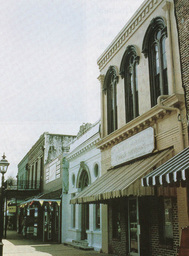 Click image to enlarge.
Click image to enlarge.
Brown's Department Store, Tuskegee, Marion County, mid-19th century (Places in Peril 1994)10/24/1994  Click image to enlarge. Click image to enlarge. Behind the Italianate facade of this building is a mid-nineteenth-century retail interior incomparable in Alabama. The focal point is a freestanding stair that corkscrews upward through a tiara-like well to the second floor. A handsomely coved and molded ceiling, ornamented plasterwork, and balustraded light-well complete a setting that affords a rare glimpse of an upscale antebellum commercial interior. It is conceivable that the architect was John Stewart of the preeminent Philadelphia firm of Sloan and Stewart. Stewart was active in Alabama during the 1850s.
1 Comment
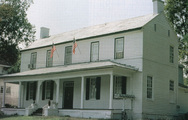 Click image to enlarge. Click image to enlarge. This 1835 structure is one of the Tuscaloosa area's earliest and last remaining examples of a Federal-period I-house. (An I-house is one whose main block is two stories high but only one-room deep, hence its tall and narrow I-like profile.) The structure is also important as the residence of Judge Marmaduke Williams (1774-1850). Williams, a key member of the 1819 Alabama Constitutional Convention, was married to Agnes Payne Harris, a first cousin of Dolley Payne Madison, wife of President James Madison. 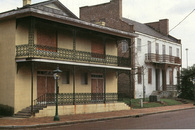 Click image to enlarge. Click image to enlarge. A cluster of nineteenth-century houses of varying ages forms what has been designated as "Fort Conde Village," a four-square-block area next to Fort Conde and near the waterfront in downtown Mobile. One of Mobile's earliest residential districts, the village contains some of the city's oldest and finest houses. The Edward Hall House, built in 1836 of stucco with a frame second story, shows a strong Creole influence in the first- and second-story galleries, as well as in the kickoff roof. Likewise notable is the Spear House, dating from 1857. The village also contains several of the more modest homes of the period, making it a valuable repository of vernacular as well as high-style architecture. 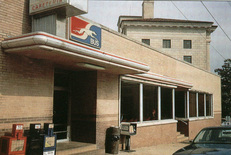 Click image to enlarge. Click image to enlarge. Montgomery's Greyhound Bus Terminal is one of those ordinary buildings that has been "rendered extraordinary" by the events that occurred within it. On May 20, 1961, twenty-one young Freedom Riders, hoping to end discrimination in the interstate transportation system, pulled into the Greyhound Bus Terminal in Montgomery and were met by an angry mob. The riot that ensued prodded the Kennedy Administration along the road to civil rights reform and signaled the country that there was no turning back for either side (both for segregationists and civil rights advocates) on the issue of civil rights. |
Alabama's Endangered Historic LandmarksEach year since 1994, Alabama Heritage has highlighted threatened historic sites throughout Alabama. The “Places in Peril” list has identified more than 215 imperiled historic resources throughout the state, and is compiled by the Alabama Historical Commission and the Alabama Trust for Historic Preservation. The locations highlight the results of deferred maintenance, perceived obsolescence, development pressures, and lack of funding—forces that now more than ever threaten our cultural legacy. But awareness is a powerful force, too, and can cultivate a renewed determination to be responsible stewards of our heritage. For more information, visit the AHC or the ATHP websites. Alabama Heritage is proud to bring to you a selection of the places designated as perilous. Please keep your comments to information relevant to the featured place in peril. Alabama Heritage reserves the right to delete any comment that we deem inappropriate. Archives
May 2024
|
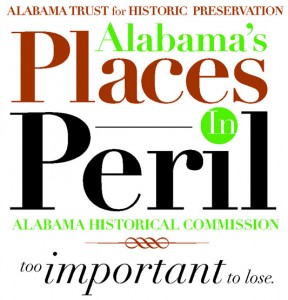
 RSS Feed
RSS Feed